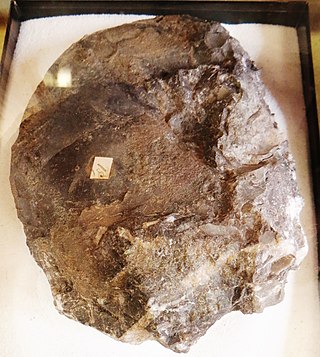
The Nautilida constitute a large and diverse order of generally coiled nautiloid cephalopods that began in the mid Paleozoic and continues to the present with a single family, the Nautilidae which includes two genera, Nautilus and Allonautilus, with six species. All told, between 22 and 34 families and 165 to 184 genera have been recognised, making this the largest order of the subclass Nautiloidea.

The Oncocerida comprise a diverse group of generally small nautiloid cephalopods known from the Middle Ordovician to the Mississippian, in which the connecting rings are thin and siphuncle segments are variably expanded. At present the order consists of some 16 families, a few of which, such as the Oncoceratidae, Brevicoceratidae, and Acleistoceratidae contain a fair number of genera each while others like the Trimeroceratidae and Archiacoceratidae are represented by only two or three.
The Brevicoceratidae is a family of oncocerids that contains genera characterized by exogastric gyrocones, brevicones, and torticones. that tend to develop vestigial actinosiphonate deposits and subtriangular transverse sections. The Brevicoceratidae are derived from Oonoceras (Oncoceratidae) and range from the mid-Silurian to the Upper Devonian.
Strophiceras is an extinct genus of cephalopods from the Order Nautilida, which includes, in a separate family, Nautilus and Allonautilus.
Jovellania is a genus of extinct prehistoric nautiloids from the order Oncocerida known from the Lower Devonian of Europe. Nautiloids form a broad group of shelled cephalopods that were once diverse and numerous but are now represented by only a handful of species in two genera.
Brevicoceras is an extinct nautiloid genus from the order Oncocerida with wide distribution in the Middle Devonian in Eastern North America, Russia and Morocco. Nautiloids form a broad group of shelled cephalopods that were once diverse and numerous but are now represented by only a handful of species in two genera.
Streptoceras is a genus in the extinct oncocerid family Acleistoceratidae that plied the shallow sea floor from the Middle Silurian to the Middle Devonian. Streptoceras is characterized by a shell that is large but short in proportion (breviconic) with the ventral profile convex and dorsal profile concave in the posterior part, convex over the body chamber, then concave toward the front, like Amphycertoceras, but with a triangular shaped aperture. Streptoceras is found in the Middle Silurian of North America, in Ontario.

Orthoceratoidea is a major subclass of nautiloid cephalopods. Members of this subclass usually have orthoconic (straight) to slightly cyrtoconic (curved) shells, and central to subcentral siphuncles which may bear internal deposits. Orthoceratoids are also characterized by dorsomyarian muscle scars, extensive cameral deposits, and calciosiphonate connecting rings with a porous and calcitic inner layer.
Jovellaniidae was established as a family within the Oncocerida to include genera characterized by longiconic orthocones and cyrtocones with a subtriangular to depressed cross-section in which the ventral (siphuncular) side is typically angular or more acutely rounded than the dorsal (antisiphuncular) side, and in which the siphuncle is generally large, ventral, and with lamellar actinosiphonate deposits
The Graciloceratidae is a family of nautiloid cephalopods from the Middle and Upper Ordovician belonging to the Oncocerida, characterized by exogastric cyrtocones that expand slightly or moderately and have thin walled, orthochoanitic marginal or subventral, tubular siphuncles.

Oncoceratidae is a family of nauatiloid cephalopods in the order Oncocerida established by Hyatt, 1884, that range from the Middle Ordovician to the Upper Silurian.
Hemiphragmoceratidae is a family of endogastrically brevconic oncocerids characterized by elaborately visored apertures in which the hyponomic sinus in mature specimens is on a spout-like process and there may be lateral and dorsal salients.. Shells are compressed with the apical portion curved and the anterior straight. Siphucles are nummuloideal with expanded spheroidal segments and continuously actinosiphonate interiors.
The Tripteroceratidae is a family of depressed, straight to slightly curved nautiloid cephalopods from the middle and upper Ordovician with generally flattened venters and empty siphuncles with straight to inflated segments included in the Oncocerida.

The Barrandeoceratidae is a family of coiled nautiloids included in the Tarphycerida that lived from the Middle Ordovician to the Middle Devonian, characterised by mostly compressed shells with a subcentral siphuncle composed of thin-walled segments that may become secondarily ventral.(Flower and Kummel 1950, Sweet 1964).
The Uranoceratidae is a family of Silurian barrandeoceroids that tend to become uncoiled with age and in which siphuncle segments tend to be expanded into the camerae.
The Valcouroceratidae is a family within the Oncocerida, nautiloid cephalopods from the middle and upper Ordovician, established by Rousseau Flower in 1945.
Poterioceratidae is a family of nautiloid cephalopods included in the Oncocerida that lived during the period from the Early Devonian to the Early Carboniferous (Mississippian). Members of the Poterioceratidae are distinguished by a subcircular to compressed exogastric shell that has no hyponomic sinus and a central to subcentral siphuncle composed of subquadrate to nummuloidal segments in which the septal necks are more strongly curved on the upper, or dorsal side. This is opposite from the Karoceratidae in which siphuncle segments are inflated ventrally but straight dorsally. Some poterioceratid genera have actinosiphonate structures or annular deposits within the siphuncle. In others it is empty.
The Nephriticeratidae is a family of early Paleozoic nautilod cephalopods included in the Barrandeocerina, distinguished by mostly cyrtoconic as well as gyroconic, sepenticontic, and sinstrally torticonic shells with large, typically straight necked (orthchoanitic) siphuncles. As for the suborder, connecting rings are thin.
The Plectoceratidae is a family of tarphycerids in the suborder Barrandeocerina established as a place for the genus Plectoceras; defined simply as coiled, costate barrandeocerids with subcentral adult siphuncle.
Aktjubocheilus is a genus of oncocerid nautiloids from the Upper Devonian included in the Acleistoceratidae, a family characterized by depressed, or rarely compressed, exogastric brevicones and cyrtocones.





